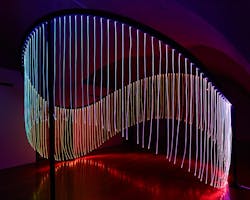Sustainability, interactive experiences and storytelling were unveiled as top trends at the 16th annual London Design Festival.
The festival serves as one of the premier events for discovering what’s hot and trending in the world of design, according to Alexei Cowan, senior editor of Lifestyle & Interiors at WGSN.
WGSN is renowned for its trend forecasting, analytics and design tools. The predictions are based on insight its forecasters gather from all over the world from trade shows, retail trends, technological advances, as well as cultural, social and economic shifts. This year’s trends show that designers and brands are interested in experimenting with new materials, technology and color, as well as focusing on the ethical and environmental impacts of design.
?! ► A Wildlife Refuge Wins Best Restrom of 2018
Sustainability
Sustainability was a focus this year as brands and designers continue to adapt their outlooks on materials and manufacturing methods, including ecological footprints, usage of materials and creating positive impacts on the environment, Cowan says. “Materials are the key, whether it is craft and natural materials, to designers finding creative ways to use waste, recycled plastic and bio alternatives. Designers and brands want sustainability to be design-led with great looks, feel and functionality.”
Previously, seasons showed a resurgence of terrazzo, cork, jesmonite, terra cotta and other sustainable materials, which has fed into self-made materials, sensorial finishes and the meaning of making. Also, Cowan notes that industrial techniques continue to be explored from year-to-year with 3D printing becoming more personal and hand worked, and with foam being molded into interesting forms and textures.
Notable designs and designers from this year’s event embraced many of these materials and transformed them in unique and interesting ways.
One example is Studio ilio, a London-based design agency that focuses on material innovation and process development. Designers Seongil Choi and Fabio Hendry explore boundaries between crafts and industry, creating:
- sculptural objects by transforming steel fibers into flexible sheets, textiles and metalwork
- furniture from a heat source, nichrome wire, and a composite of nylon powder and sand
- installations with – of all things – human hair, which is done by applying the hair to a carefully heated surface, the material carbonizes instantly and acts as a form of ink that has similarities to etching and anodizing
Another example is in recycled plastic terrazzo, which includes mixing plastic in tinsel for a firework-like effect, Cowan says. She also notes that designer Lisa Hilland has been experimenting with wood and real leather and how you can add energy with new veneers and folding and pleating techniques.
Interactive Storytelling
Interactive experiences and storytelling design trends also played a big part in this year’s festival. This trend is being driven by drawing from real life and fictional pasts, whether historical or imagined.
“Installations are to be explored and engaged with, taking people on journeys,” Cowan explains.
In addition to sustainability and interactive storytelling, other notable trends included the promotion of conscious consumerism, technology, natural wellness, crafted imperfections, experimental monolithic furniture and re-edited pieces that brought fresh thinking to existing works.
Trends on the Horizon Beyond London Design Festival
Looking ahead into 2019 and beyond, Cowan anticipates that materials, tactility and color will continue to drive design, with natural materials growing more important with new applications of stone, wood and cork – matte finishes and clay surfaces will bring calmness into homes and workspaces.
“Terrazzo and marble will continue to be a star joining forces with recycled plastic and new composites, in colorful combinations and tone-on-tone mixes,” she says.
Color remains a key design element. Deep palettes will remain popular as they add mystery and richness to interiors, blush tones become core colors with warm and calming tones, and green will remain popular as it complements natural elements that are being introduced into more spaces.
“Green will continue to play an important role in color and grow in strength with the relationship of botanical aesthetics in the home,” Cowan says. “And baked warmth will be key with terra cotta remaining an important saturated hue.”
More Design News ► Daily Updates | Joanna Gaines Enters Commercial Design | The Wing’s New Brooklyn Location Is Fit for a Queen
About the Author

Rachel Kats
Former Staff Writer
Rachel was an interiors+sources staff writer. She has years of experience covering everything from government and education to feature topics and events. A Wisconsin native, she holds a bachelor’s in mass communications and journalism from St. Cloud State University.
